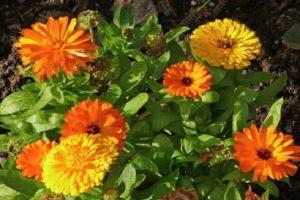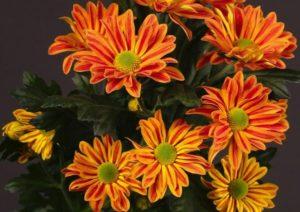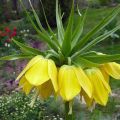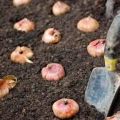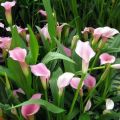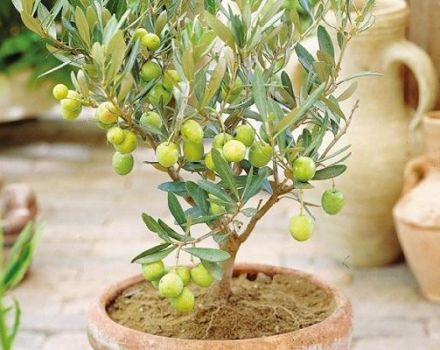Planting and caring for autumn crocus (colchicum) in the open field
Kolhikum, he is a colchicum or in another way an autumnal, is a very mysterious plant, which attracts flower growers. Today, colchicum is widespread everywhere, earned popularity for its ability to release fragrant flowers without foliage in the fall, the latter, in turn, appear in the spring. Planting in the open ground of a colchicum and caring for it will be the simplest thing for you, but how much pleasure it will bring to observe the most delicate peduncles.
Description and characteristics
Colchicum is a perennial with short stems, lanceolate leaves of dark green color and large peduncles of various colors - from pink to lilac, with various blotches and veins of dark shades. Some species of colchicum have the ability to release greens in early spring and die off by the beginning of the summer season..
Colchicum root is presented in the form of an elongated bulb. Autumn bloom begins in the fall, at the end of September, and continues until the end of October. The peduncle has a height of 20 centimeters, ends in a beautiful, rather large flower, up to 8 centimeters in diameter. Some specimens may be smaller. Colchicum looks spectacular in autumn, when a spot of colorful funnel-shaped flowers appears on the already blackened soil, without greenery.
Features:
Colchicum has a number of features:
- Outwardly, and the ability to bloom in autumn or spring, colchicum resembles crocuses. But the second flowers are slightly smaller in size.
- Another feature of the plant is the appearance of a seed capsule together with green leaves in early spring. Closer to June, the fruit ripens, forming seeds.
- It is worth noting that colchicum belongs to poisonous flowers, therefore, if there are children in the house, they should not be allowed to approach the plant.
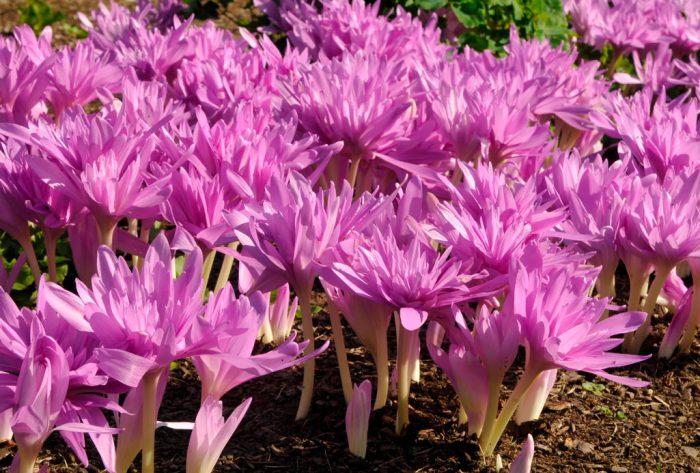
Despite the danger of the flower, it is still loved and fruitfully grown, decorating the garden in the fall, when the foliage becomes withered, and many flowers simply fade.
Cycle of life
Colchicum is a rather unusual flowering plant. Succulent large leaves appear in spring. Their greenery is simply pleasing to the eye, from above they seem to be watered with wax, due to which they seem shiny. By the beginning of summer, the foliage dies off, and does not appear until the next spring.
One bulb can produce up to five inflorescences, which appear in September, as already noted. The seed box of colchicum does not come out, as usual, to the surface, and in winter it develops in the bulb. With the onset of spring heat, it comes to the surface of the earth with foliage.Once the fruits are brown, they are cut and wait for them to open to collect the seeds.

Interesting! This cycle of life is associated with natural natural growing conditions. Colchicum is a native of the Mediterranean countries, where the summer period is rather dry, so the flower after spring seems to retire, stores up energy and nutrients, and blooms in the autumn months.
Beneficial features
Despite the fact that the plant is from a number of poisonous, it is actively used in folk medicine. Colchicum has the following effect on the human body:
- The substance colchicine is the basis of medicines for gout and inflammation of the walls of the blood veins (phlebitis).
- Medicines from colchicum are used in violation of protein metabolism and joint diseases.
- Colchicine is used to create tablets for use in dentistry.
- The second most valuable substance produced from the crocus is Kolchamin. Medicines with it in the composition are used to treat cancer.
- Colchicum herb has a diuretic effect.
- Decoctions and infusions have long been used for rubbing with rheumatism, osteochondrosis and other diseases of the musculoskeletal system.

Even having an idea of colchicum poisoning, they use it with caution to induce vomiting, and as a laxative medicine.
Growing from seeds
This method of reproduction of colchicum is rarely used, since it is very long, and you have to wait 6-7 years to contemplate flowering. During this time, the bulb will be able to gain strength and get stronger in order to develop a flower bud.
Important! There are only a few species of crocus that propagate by seed, blooming in spring and with a single bulb (without daughter root formations), for example, yellow colchicum.

Procedure for growing a plant from seed:
- A loose, fertile soil mixture is prepared. Moisturize slightly.
- Sowing is started at the beginning of summer, immediately after the collection of seeds.
- Before placing in the ground, the seed is soaked in clean water for a few minutes.
- Then the colchicum bulb is embedded in the soil, to a depth of 0.5-1 centimeter.
If the moment of timely planting is missed, then it will be possible to sow the seeds of colchicum in six months, and during this time the seeds must undergo stratification. For this, the seeds are wrapped in paper and placed in the refrigerator.
Caring for young seedlings of colchicum is very simple, it consists of the following agrotechnical actions:
- loosening of spring seedlings;
- thinning;
- regular watering of the greens until the leaves die off;
- weeding;
- shelter for the winter with dry grass, spruce branches, covering material.
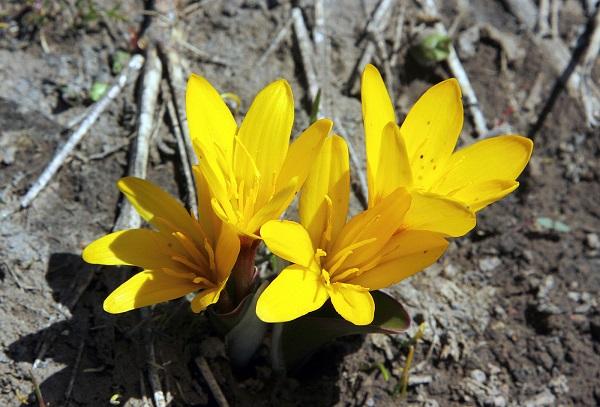
In the first year of sowing, you may not find seedlings, but they will appear the next year, therefore, in order not to miss this moment, the place where the flower was sown should be noted.
Landing in open ground
What growing conditions should be provided for colchicum:
- The soil must be fertile. Does not require transplanting to a new location for 6 years
- The flower can be either lit or in the shade. Colchicum is usually planted under tall trees.
- It does not show any special requirements for moisture.
Important! If the groundwater passes close to the soil surface, then bulbs cannot be planted in this place.
When to plant
For colchicum blooming in autumn, planting is organized in August. A flower stalk may appear in a couple of weeks, but if the bulb is large and has a large supply of nutrients. If you plant the planting material in October, then the flower will appear next fall.
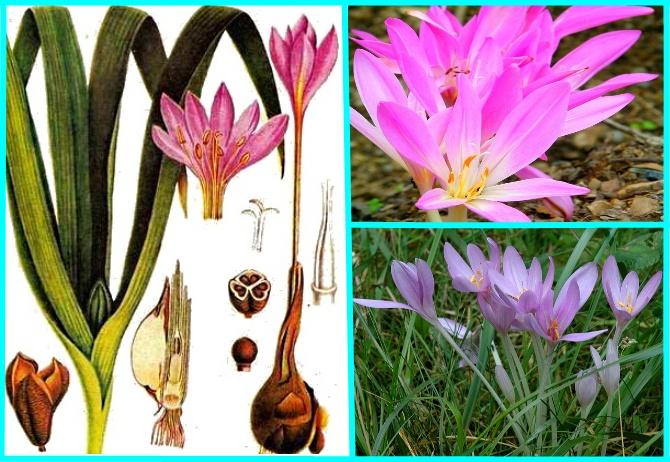
How to plant
The process should be performed according to the following algorithm:
- They plan a place for a flower bed of colchicum.
- The bulb planting scheme is observed: between neighbors - 10-20 centimeters, in depth - 8-20 centimeters. These parameters should be taken into account depending on the diameter of the bulb. If the root is small, then the depth is reduced; if the root is large, then it is planted deeper.
- Mineral fertilizers are applied to the marked bed: superphosphate, at the rate of 1 tablespoon per square meter, and 1 liter of wood ash. Top dressing is closed by loosening or digging. In addition to minerals, organic matter is introduced: 10 kilograms of humus and 5 kilograms of sand per 1 square meter.
- The bulbs are deepened into the soil, leaving a long tube on the soil surface. This tube serves as a place for the peduncle to exit.
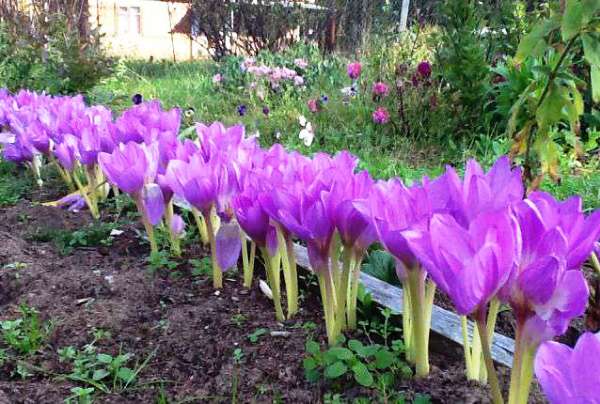
After the bulbs are immersed in the soil, the flower bed should be spilled abundantly and a layer of mulch should be applied on top so that the moisture does not evaporate quickly.
Choosing the right place
It is customary to see croplands in the shade of fruit bushes. In the spring they are sheltered from the scorching sun, and in the winter, the flowers are covered with fallen leaves. Colchicum beds are usually not placed separately, since during the summer the plant is completely absent, which means that the place will be empty, therefore their cultivation is combined with other plants.
The bulbs go deep, which means that creeping flowers with a fibrous root system can be planted on the surface, for example, periwinkle, various tenacious. Even if the colchicum dries up, ground cover creepers will hide dead wood.
Care
Kolhikum is loved by gardeners for its ease and low demands. Special attention should be paid to the spring feeding and transplanting of bulbs when caring for the autumn autumn. How does this happen?
How to transplant to another location
In one place, crocus is allowed to grow for 6-7 years. Further, he requires a transplant. Usually, in the fall, a lot of leaves concentrated in a bunch appear, which means that daughter bulbs have grown on the uterine bulbs. Such colchicums will stop blooming in the fall and begin to hurt. It is necessary to start digging the bulbs in late spring, early summer, when the greens are completely dry. You need to transplant to a new place in August. During this period of time, the bulbs are thoroughly washed, processed with potassium permanganate, and dried. In this form, they are stored in a cool dark place until August.
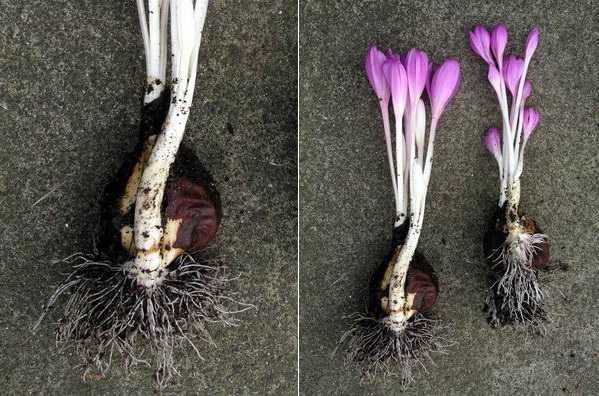
Diseases and pests
Snails and slugs are frequent guests on croplands. They are attracted by the lush green foliage, especially since the plant usually grows in the shade of other shrubs or tall flowers. Any insecticide is used to control pests. To prevent the snails from attacking the autumn people, eggshells are laid out on the flowerbed, small pebbles are scattered. With abundant humidity, the leaves become covered with gray rot. Fungicides for any flowering plants help here: Topaz, Champion. You should also remove heavily damaged shoots, and let the soil dry out before the next watering.
Top dressing and watering
You should start feeding Kolkhikum in the spring, when leaves appear from under the ground. Nitrogen fertilizers are applied to the surrounding area. This will allow the plant to have very large leaves that will store enough nutrients in the bulb for further flowering. In the fall, any organic fertilizers or mineral complexes for flowering plants are introduced for digging.
In the spring, when leaves appear, the flower does not need high humidity, that is, watering. The reserves of melt water will be enough for the leaves to grow. And sunlight as well.
When buds begin to hatch from the ground, and the trees have not yet acquired foliage, the colchicum has enough illumination, then, before the greenery dies, light is also not needed. During flowering, the foliage on the trees no longer exists, so the peduncles bathe in an abundance of light. And you do not need to water, since the colchicum is preparing for a dormant period. In general, it is easy to care for the plant in this regard.
After flowering
Many gardeners begin to trim slightly drooping parts of the plant. This cannot be done. The plant will get rid of its elements on its own when the moment comes. And as the bulb grows, it gains strength and nutrients.
Main types and varieties
The most popular and demanded are the autumn-flowering colchicums.Less often there are prominent peduncles in spring, so less attractive. Today croplands are full of a variety of varieties that differ in size and color palette. Below, in the table, we will try to present the most beautiful and fashionable varieties.
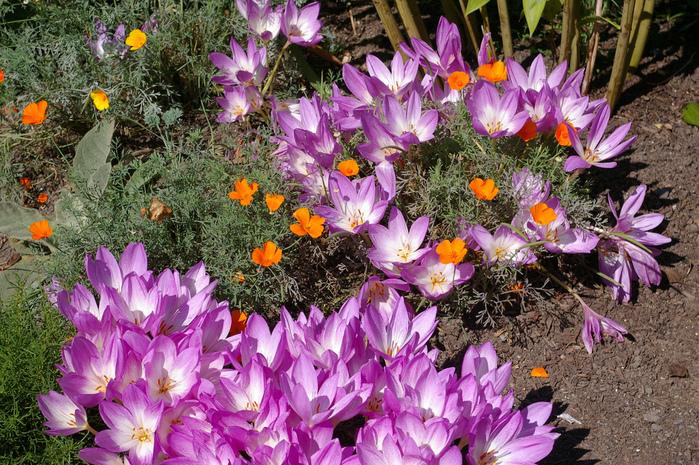
| Variety name | Latin name | Height, diameter, centimeters | Flowers, leaves | Distribution area | Flowering time |
| Spring blooming | |||||
| Hungarian | hungaricum | up to 15 / 4-5 | white, deep pink, with burgundy anthers on stamens and fluffy leaves | steppe zone of Albania, Greece, highlands of Yugoslavia | February March |
| Yellow | Colchicum luteum | up to 15/3 | lemon yellow flowers with long green leaves, 2-3 flowers emerge from one bulb | Tien Shan mountains, Tibet, Pamir, Kazakhstan | March, April |
| Ankara (three-leafed or bieberstein) | ancyrense, biebersteimi, triphyllum | 10-15/5 | lilac-pink color of flowers, up to 8 pieces from one bulb, the leaves are narrow, resembling a bluish groove | Ukraine, Moldova, Turkey, Crimea | December-April |
| Tuberous | fasciculare | 10-20/3-4 | pale pink or white flowers in a bunch | Libya, Lebanon, Israel | February March |
| Regel (Kesselring) | regelii, crociflorum, kesselringii | up to 15 / 2-3 | leaves - up to 7 pieces, long, with a blunt end and serrated edges, white flowers, with a pink stripe on the outside of the petals | March | |
| Bifolium (two-leaved) | bifolium | 10-15/3-4 | flowers are pink and purple, leaves are dark green, tubular, oblong | Armenia | March, April |
| Sovicha | szovitsii | 10-12 / up to 6 | white and pink large flowers, framed by a rosette of short leaves | Mountains of Armenia | February March |
| Autumn blooming | |||||
| Autumn | autumnale | 40/7 | flowers are white, light lilac, sometimes double | western France, Latvia, Carpathians, England - meadows and forests | October |
| White | autumnale | 15/7 | boiling white perianth with a yellow center | European countries | September, from the 15th |
| Terry | autumnale | up to 12/5 | lilac flowers, dense double, leaves are wide, up to 4 centimeters, 25 centimeters long | Europe | End of october |
| Neddiste | autumnale | 10/5 | pink flowers | Czech Republic | September October |
| Agrippa | agrippinum | 40/2 | purple flowers, 3 copies emerge from one bulb | Asia Minor | August-October |
| Bornmüller | – | 12-15/8 | pink flowers with a slightly darkish base | Syria, Iran, Asia Minor | September-November |
| Great | |||||
| Huxley | speciosum | up to 50 / 3-4 | lilac, pink flowers, turning into more saturated colors | Transcaucasia, Turkey, Iran | September |
| Waterlely | speciosum | up to 50 / up to 5 | purple flowers, double | Caucasus | September |
| Premier | speciosum | up to 45 / up to 5 | flowers are bright, pink-lilac | Caucasus, Turkey | October |
| Byzantine | – | up to 15/7 | lilac-pink flowers, 12 pieces per bulb | – | Aug. Sept |
| Cilician | – | 20-60/7-8 | lilac-pink flowers or purple, with white veins, leaves - wide folded | Mediterranean, Turkey | early autumn |
| Kochi, decorative | – | 8/4-5 | flowers of white or pink color | Iran, Turkey, Iraq | Aug. Sept |
| Motley | – | 10-30/ | creeping leaves, 3-4 pieces, with a wavy edge, 1-3 flowers on one stem, various shades of pink, with a checkerboard pattern | Greece | fall |
| Shady | – | 8-10/4-5 | 1-3 flowers from one bulb, light pink, lily leaves, long, up to 15 centimeters, 2 centimeters wide | Crimea, Turkey, Iran, Iraq | September |
| Fomina | – | 10-15/ | various shades of purple | Russia, Ukraine (Odessa), Moldova | late August-mid-October |
| Waterlily | WATERLILY | 23/10-15 | aster-like double bud of bright pink color | – | early autumn |
| Dark purple | atropurpureum | 10-15/ | small flowers of dark purple color, spring leaves are long, up to 20 centimeters | Turkey | September |
| Neapolitan | neapolitanum | – | lilac, pink flowers, white border along the edge of the petals, with sharp petals | – | end of August |
| Pannonian | pannonicum | – | flowers of various shades of lilac, with white stripes | – | fall |
| Sibthrop | sibthorpii | 20-50/5-8 | from one bulb there are 1-7 flowers of lilac-pink color, with a spotted pattern, with brown stamens | Bulgaria, Greece, Crete | fall |
| Stevina | stevenii | – | flowers of 3-10 pieces from one bulb, purple and pink | Mediterranean | october-february |
| Jerusalem | hierosolymitanum | – | leaf width - up to 2 centimeters, inflorescence color pink | – | fall |
| Trudy | troodi | – | flowers are pale pink, almost white | Upper Galilee, Golan, Hermon | – |
| Bright | laetum | 10-12/7 | flowers are pale pink, 1-3 pieces on one peduncle, leaves - 3 pieces, 2-3 centimeters wide | Lower Volga region, Ciscaucasia, Dagestan | mid-October-November |
| Alboplenum | – | 22/5-6 | white double flowers | – | fall |
| Giant | – | 30/15-20 | flowers of pinkish-lilac color with a white bottom | – | September |
| Hybrid | |||||
| Autumn Herald | Autumn herald | – | the outer side of the flower is amethyst purple in color, and the inner side is purple-purple, in the center is a pale yellow spot with bright orange anthers | – | September |
| Princess Astrid | Princess astrid | – | inside the perianth a purple spot, and the perianth itself is white | – | fall |
| Dick Trotter | Dick trotter | – | perianth purple, with a center in the form of a green spot | – | October November |
| Violet Queen | Violet Queen | 30/12 | flowers of deep purple color, petals with visible white veins, reminiscent of an openwork pattern | – | September |
All species and varieties are hardy, resistant to drought and severe frost. In addition, hybrid varieties can be found in any catalog of floral and ornamental plants.
Reproduction
You can propagate the crocus in two ways: by seeds and bulbs.
Seeds
A laborious process in terms of waiting for the ejection of peduncles that appear in 6-7 years.
Bulbs
Vegetative reproduction involves the separation of daughter bulbs, which grow every year. When many stems with leaves appear in the spring, it means that children have grown on the mother liquor. They are dug up in August, stored until October, when they are planted. Colchicum in the garden is a decoration of any flower bed: in spring it pleases with large tall leaves, in autumn - with spectacular flowers of various colors. We have highlighted a wide selection of varieties and types of colchicum to assist with purchasing. You can create compositions involving several varieties at once, the main thing is to have imagination, and the plant will thank you for this with a lush, fragrant flowering.
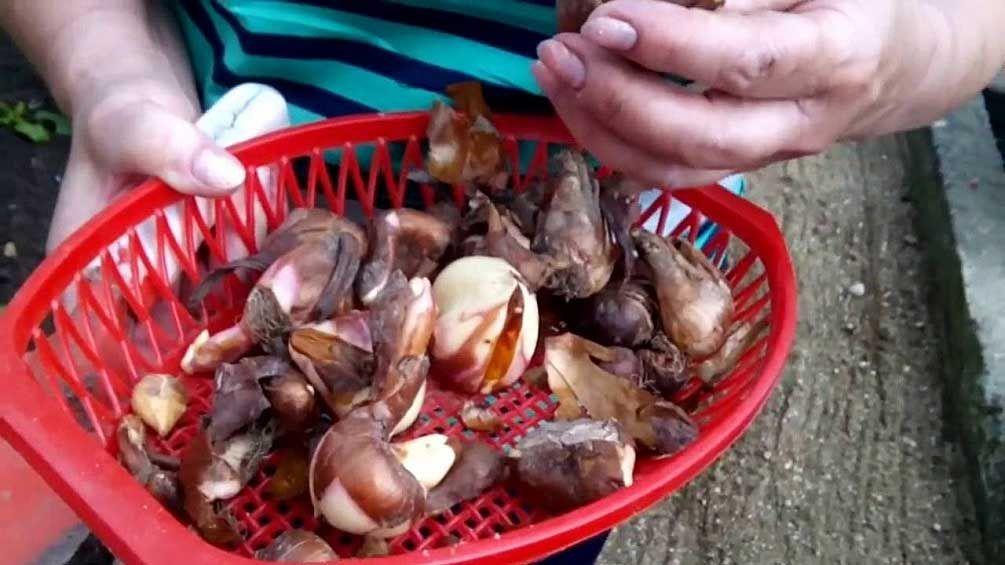
Answers on questions
Due to the unusual growth of a flowering plant, many novice summer residents ask questions, to which they receive answers from knowledgeable people:
- Why did the flowers get smaller? Most likely, the growth of daughter bulbs occurred. The tubers receive less nutrients, and they themselves are smaller, so the flower stalks are smaller. Splitting the nest will help solve the problem. For this, in June, July, a plant is dug up, and in August they are planted in a new place.
- How often to transplant colchicum? Strong growth occurs in 4-5 years, therefore, by the fifth year, when about 12 peduncles appear from the ground, the plant must be transplanted.
- In what form can plant poisoning occur, and which parts of it are the most poisonous? Colchicum is poisonous in everything, from the bulb to the seeds. Eating 6 grams of seeds can cause irreversible reactions in adults, while the child can die. The first signs are vomiting, diarrhea, lymphocytosis. Therefore, in order to protect yourself and your household, you should not dry and keep the bulbs in an accessible place, and when the plant has come to the surface, they make sure that the children do not come close to the flower bed.

Reviews
Vladimir, 55 years old, Barnaul.
“I live in harsh Siberian climatic conditions. Winter brings surprises every time. Every year in the garden you have to part with any plant that has not survived the next severe frosts. I want to express my delight in favor of the crocus. I planted it under an apple tree. A currant bush grows on one side, a gooseberry on the other. It turns out that even in a winter with little snow, the flower bed is covered with snow. This is how my colchicum is preserved, not covered by anything. Frosts in Altai can be up to -42 degrees.It's a pity that you don't have to see beautiful large flowers in the summer. "
Olga, 36 years old, Saratov.
“I have known Colonel not so long ago. I liked the rather spectacular dark green leaves that the old woman was selling on the market. I thought there would be a large flower. Well, I planted it in my garden. When he disappeared after a while. I think that's all - gone and gone. But in the fall graceful pink flowers appeared, and it was then that I remembered why flowers suddenly bloomed in this place ”.
